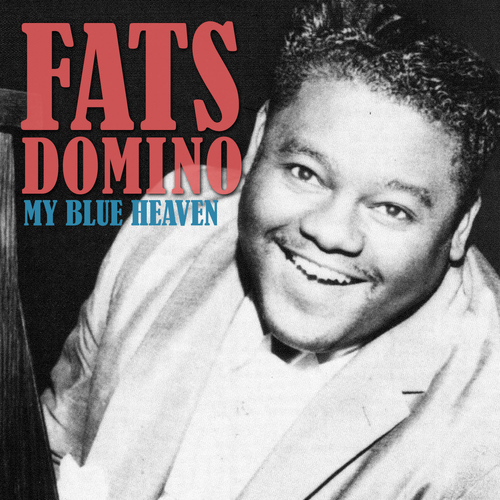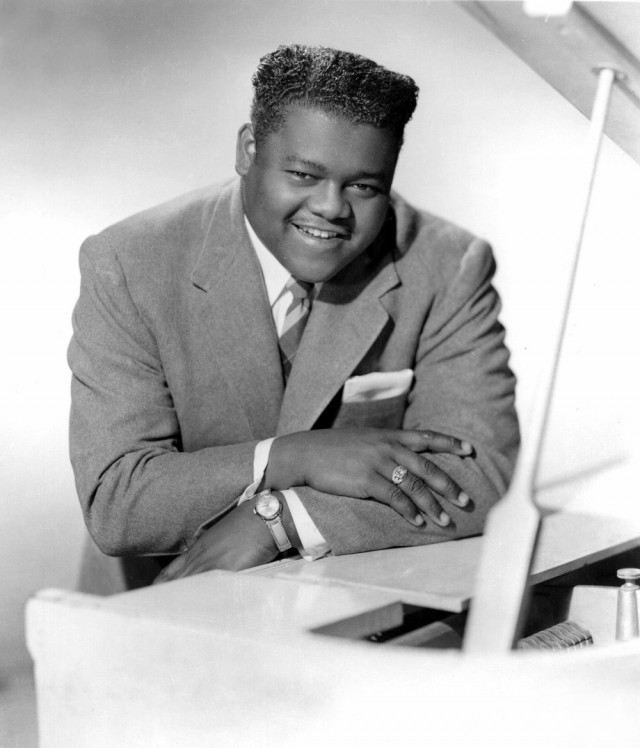
In the US there were another six more lowly placed singles on the main chart, It was 1959 before Fats had another major US hit, ‘Whole Lotta Loving’ got to No.2 on the R&B chart in November and No.6 on the Hot 100. In 1957 ‘I’m Walkin’ was another R&B No.1, a Billboard No.4 and a UK No.19, Valley of Tears an R&B No.2, a No.8 on Billboard and UK No.25.

His next hit in early 1957, ‘Blue Monday’, was from the Jayne Mansfield film The Girl Can’t Help It, was an R&B No.1 and got to No.5 on the main chart it could only manage a more lowly No.23 in Britain. It was also covered by Elvis, Rick Nelson, Andy Williams and in 1976 by the Beach Boys. It made No.6 in the UK chart and in the process became the biggest of his twenty British hits it also charted again in Britain in 1976. If a record says hit from its opening notes it’s this.

‘Blueberry Hill’ is quintessential Fats! Quintessential rock ‘n’ roll, but originally it was a hit for Glenn Miller with a vocal by Ray Eberle. His next major hit was ‘Blueberry Hill’ written by Bobby Cerdeira, Al Lewis and Larry Stock. In 1956 ‘I’m in Love Again’ made No.3 on the main chart having also topped the R&B chart. Interestingly, Fats learned to speak English after he first learned to speak French and you can hear his accent coming through if you listen hard to some of the early recordings.

In the UK it became a hit for Fats in early 1957, making No.23.įats’ success with white audiences was in some ways amazing because he did it without radically changing his musical style, a style that owed a great deal to the big band sound of New Orleans, honking saxes and a driving beat. Its progress on the main Billboard chart was hampered by a cover version by Mr Vanilla, Pat Boone, who took it to No.1. In May 1955 it entered the R&B charts and ended up spending 11 weeks at No.1. Most people think this song is called, “Ain’t That A Shame”, because that is what Fats sings, but on the label, it is definitely ‘it’. He called it rock-and-roll.” – Fats Domino I used to hear a lot of those shows on the radio. A fellow by the name of Alan Freed, he used to have a big old show out of the Brooklyn Paramount in New York. “ We called it rhythm-and-blues back then. It was ‘Ain’t It A Shame’ that crossed over to the pop chart making No.10 and introduced Domino to a wider audience. He followed it with two more top 10 R&B hits and then in 1952 had his first No.1 on the R&B chart with ‘Goin’ Home’.įrom the remainder of the 1950s, he was rarely off the R&B chart, having top 3 records with, ‘Going To The River’ (1953), ‘Please Don’t Leave Me’ (1953) and ‘Ain’t It A Shame’ (1955). In 1949 Bartholomew took him to the Imperial label to record, within a few months they had their first hit, ‘The Fat Man’ got to No.2 on the R&B chart in early 1950. He skipped school in his early teens and having been influenced by Albert Ammons and Fats Waller he began playing the piano in New Orleans nightclubs, which is where he met and worked with bandleader Dave Bartholomew. “His ample and genial presence, more than any other, embodies the spirit of New Orleans, the cradle of jazz.” – Mick Brown writer and Phil Spector biographerįats was born in New Orleans and as a small child, he learned to play the piano from his brother in law, making his debut at 10 years old. His 1949 recording, The Fat Man sure sounds like rock n’ roll to me, so he’s another that can claim to have been there at the birth.

Fat’s predates what most people consider the point at which rock ‘n’ roll began. In thirteen years Antoine ‘Fats’ Domino put 66 records on the Billboard chart not a record, but still a formidable achievement and with the exception of Elvis, no other rock ‘n’ roller had such success.


 0 kommentar(er)
0 kommentar(er)
